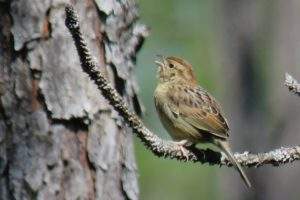AOS/eBird Project Update
By Ken Hare and Greg Harber

Bachman’s Sparrow (Photo Ken Hare)
In early 2017, the Alabama Ornithological Society answered a call to increase the data readily available to researchers on Cornell University’s eBird from Alabama counties that had few eBird reports, which potentially could skew future research on such issues as bird migration.
When the AOS board agreed to take on this mission at the request of eBird staff, AOS members thought the project would take until at least 2020 to complete. But in just 20 months, the AOS team working on the project met its initial goals.
When in 2016 Alabama Ornithological Society President Anne Miller started focusing attention on the issue of poor reporting on eBird of birding records in many rural Alabama counties, improving reporting seemed a daunting task. In an article that year in the AOS newsletter, The Yellowhammer, Miller wrote that almost half of Alabama’s 67 counties were “seriously under-reported” (See more here).At that time, there were many counties where the number of species reported was far below the Alabama median, there were several counties with fewer than 30 eBird checklists all-time, and there were huge gaps in the weeks in which eBird reports were filed from many counties, sometimes missing entire migration seasons.
To further focus attention on the issue, Miller invited eBird Project Leader Marshall Iliff to be the speaker for the AOS meeting in January 2017. Iliff highlighted that eBird data was increasingly being used by avian researchers and was a factor in developing public policy on protecting birds, and emphasized the problems created by the under-reporting of data in Alabama, as well as other states. The AOS board accepted that challenge, and created a committee co-chaired by Greg Harber and Ken Hare to develop strategies to increase reporting from these areas.
The first task was to establish current baseline data on the under-reporting issue, Once that was in hand, the committee decided to focus on the 16 Alabama counties with fewer than 150 species reported all-time, with special emphasis on the 10 of those counties that had fewer than 150 complete checklists all-time.
Strategies shifted over time, but eventually settled in to four approaches.
The first was to promote eBirding in these 16 counties on social media sites, in AOS publications, and on Albirds, an AOS “list serve” used by many Alabama birders to share such information as sightings of rarities. This was designed to get all birders, not just AOS members, to do eBird reports from these counties. This was a significant factor in our approach, and one we plan to continue into the future.
The second approach was to lead organized field trips to one of the least reported counties in the state. This effort was led by co-chair Greg Harber, who is also Birmingham Audubon’s field trip chairman, and was a significant factor in getting the number of species in Fayette County up. Also, by promoting these field trips in the local newspaper and on social media, the trips provided an avenue to promote eBirding in general and birding in the targeted counties specifically.
The third, and by far the most successful strategy, was to invite some of the state’s best and most prolific birders to join an “AOS/eBird Project Team” by agreeing to do reports several times a year in one or more of the targeted counties. Many of the members of this team far exceeded their original commitment, birding many times in multiple counties. (See the list of team members below.)
Using both social media and personal contacts, our fourth strategy was to urge birders in the state who had old lists not on eBird to enter those lists when they had sufficient data to do so. This strategy was especially important because it added historical perspective to the eBird data from the targeted counties. One team member, Jud Johnston, had records of several less common species from targeted counties, but only limited information on his personal lists. He dug into the archives of the Albirds list serve to find dates, times and bird descriptions to verify his historical reports on eBird. Another team member, Carrie Threadgill, took her Alabama Breeding Bird Survey reports from several years and entered them into eBird.
The results were impressive. The effort to address the under-reporting issues in these counties began in earnest in April 2017. By January 2019, just 20 months later, we had reached our goal of a minimum of 150 species in the 16 target counties and 150 complete checklists in the 10 checklist target counties.
In doing so, we raised the average number of reported species in the 16 target counties from 127 species to 163. In the 10 counties with fewer than 150 checklists, the results were even more impressive. The average number of complete checklists in those counties zoomed from 80 to 287.
“This data from these under-covered counties is much more than the fun stats game to try to find first county records and boost the overall counts,” said eBird Project Leader Marshall Iliff. He pointed out that eBird relies on reports from reliable birders to do science-based modeling with eBird data.
“These models depend on having representative data from most parts of the country, and the blank spots in Alabama that are getting filled in have way more value than yet another checklist from a well-covered region,” Iliff said. “The information content per checklist from an uncovered county is really valuable to eBird. So thanks to all!”
Counties with fewer than 150 Species : February 2017 (update January, 2019)
(Second update January 2021)
Bibb: 140 (157) (174)
Blount: 144 (177)(191)
Chilton: 129 (157)(186)
Choctaw: 122 (171)(176)
Coffee: 133 (167)(176)
Conecuh: 131 (160)(163)
Crenshaw: 104 (156)(166)
Fayette: 111 (159)(167)
Greene: 133 (153)(163)
Lamar: 96 (151)(159)
Marion: 118 (179)(185)
Pickens: 137 (163)(174)
Pike: 125 (163)(172)
Randolph: 139 (177)(182)
Walker: 137 (161)(177)
Washington: 147 (157)
Total: 2,046 (2,608) 27.4% increase
Average: 127.9 (163)
Counties with fewer than 150 checklists: Feb 2017 (Update January 2019)
(Second update January 2021)
Choctaw: 58 (410) (533)
Conecuh: 53 (202) (330)
Crenshaw: 34 (286) (361)
Fayette: 25 (166) (241)
Greene: 138 (513) (651)
Lamar: 33 (172) (232)
Marion: 131 (190) (336)
Pickens: 118 (227) (332)
Pike: 99 (368) (485)
Walker: 117 (342) (481)
Total: 806 (2,876) 256% increase
Average: 80 (287.6
AOS did not stop with this success, however. Strategies to keep birders returning to these counties are ongoing, with an emphasis on continuing to promote eBirding in general and eBirding in all areas of the state in particular. As part of that effort, the committee will promote “county birding” in which birders seek to do reports from as many of Alabama’s 67 counties as possible and to get as many species in each county as possible. An update on the state of these formerly under-reported counties has been added below. Thanks to the efforts of this very competent and dedicated AOS team, we have boosted the eBird reports of every one of Alabama’s counties. Even more important, eBird has caught on as standard practice with most birders here in Alabama. As our bird populations have declined, the observations of birders have become increasingly valuable. Thanks to eBird, Alabama birders are now making an important contribution to the conservation of the birds we all love.
(Members of the AOS/eBird Project Team are: Greg Harber and Ken Hare, co-chairs; Sue Moske, John Trent, Neil Gilbert, Ken Ward, Judy and Don Self, Geoff Hill, Larry Gardella, Jim Holmes, Jud Johnston, Carrie Threadgill, Anne Miller, Jordan Broadhead, Frank Farrell, James White, David McVay, and Marshall Iliff.)
